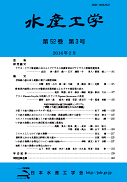
- Issue 3 Pages 83-
- Issue 2 Pages 57-
- Issue 1 Pages 1-
- |<
- <
- 1
- >
- >|
-
Nobuo Kimura2020 Volume 57 Issue 1 Pages 1-9
Published: July 31, 2020
Released on J-STAGE: July 31, 2020
JOURNAL FREE ACCESSThe seakeeping qualities of fishing vessels in Japan are generally poorer in small boats than in larger vessels. Ship motion frequently exhibits strong nonlinear responses to external forces due to the typical ship forms. This has resulted in many serious marine accidents and fatalities. To improve the safety of small fishing boats with structural vulnerabilities, it is necessary not only to understand their basic stability, but also to estimate accurately the structure of the dynamic response characteristics for external forces. In addition, the regulation of gross tonnage (GT) in the Fishing Vessel Act resulted in the restriction of various improvements of fishing vessels. Many scientists studying fishing vessels pointed out this problem, and in 2018, the law was finally revised, so the structure and safety are expected to improve in near future.
In this paper, I show some typical methodologies for studying the dynamic response structure to improve the safety of fishing vessels currently in use and of future fishing boats.
View full abstractDownload PDF (2535K)
-
Tomoki Miyamukai, Kazumasa Imao, Tomoaki Tasaki, Yuuzou Akashi, Teruak ...2020 Volume 57 Issue 1 Pages 11-25
Published: July 31, 2020
Released on J-STAGE: July 31, 2020
JOURNAL FREE ACCESSIn order to evaluate the effect of artificial rock solidified dredged soil on the organisms, we observed the appearance of diatoms, seaweeds, sessile/mobile animals, and fishes for about 2 years after setting the reef making a comparison with natural stone. And the nitrogen and carbon stable isotope ratios of the biological communities gathering on artificial reefs were compared with surrounding area.
For seaweeds, their appearances differed depending on the species, Sargassum horneri was detected on artificial stone, and Ecklonia cava tended to habit on natural stone. No clear difference was observed between the artificial rock and natural rock in the whole community structure of the sessile and mobile animals. In addition, difference among the taxonomic groups were also small from the viewpoint of appearance status resulting from the cluster analysis. However, comparing with the prey organisms in the stomach contents of fish, many Serpulidae, polycheats appeared in artificial rock. Some fishes preying on them like Acanthopagrus schlegelii and Oplegnathus fasciatus had a greater populations at prey-rich artificial rock, which suggests the relationship between biomass of prey organisms and population of fish. Although the species number of fish differed between artificial rock and natural rock, specific relationship was found neither in the raw materials, nor in biomass of prey and seaweed. The stable isotope ratios of nitrogen and carbon suggested that the artificial rock has a food linkage structure equivalent to that of the surrounding area.
View full abstractDownload PDF (2002K) -
Yousuke Fujii2020 Volume 57 Issue 1 Pages 27-34
Published: July 31, 2020
Released on J-STAGE: July 31, 2020
JOURNAL FREE ACCESSThe workforce in Japan’s fishing industry is shrinking. This study sought to identify improvements in working conditions to slow the declining numbers of fishermen and enable kelp fisheries in Fukushima-cho, Hokkaido Prefecture, to maintain current production volumes. Work and time studies were carried out to estimate fishing work times in two sample management bodies (farmer S1 and farmer S2). The findings showed that mechanizing the scraping of hydrozoa from kelp could effectively address the problem of declining workers. The study determined that if scraping hydrozoa from kelp could be mechanized, farmer S2 could cope with a loss of up to four workers from the current workforce. However, if the daily cost of running the machinery exceeds the labor cost of four workers (4,305 yen in the case of farmer S2) and if the working time per kelp is not reduced to approximately one-fourth of the current work time (11.4 sec in the case of farmer S2), mechanization will reduce the production volume from present levels. These issues can be clarified by estimating the amount of time spent working, based on the time required for operations and the numerical information that can be applied to organize and forecast fisheries’ production.
View full abstractDownload PDF (2307K)
-
Kenichi Shimizu, Mitsuharu Yagi, Ryohei Morimoto, Yasuhiro Morii, Nobu ...2020 Volume 57 Issue 1 Pages 35-44
Published: July 31, 2020
Released on J-STAGE: July 31, 2020
JOURNAL FREE ACCESSRecentry, various types of mud samplers have been used for collecting bottom sediment. Usually, Smith-Mclntyre sampler or Ekman grab sampler are used for take sediment sample. However, these conventional mud samplers are very heavy, and sometimes become danger operation in rough sea condition. The other hand, only about same volume as one spoon as, is need for analysis sediment component. Therefore, we tried to develop a new compact mud sampler which can be operated by a rod and an electric reel, and evaluated its usefulness compared with conventional grab type mud sampler. As the result, we can make one prototype compact mud sampler, which size has 1.6 kg weight in the air, L=5 cm, B=4 cm, D=7 cm and sampling volume is 140 cm3. And, we carried out actual sea experiment (Sea depth was ranged 3 m to 76 m). From this experiment, we can say that new type compact mud sampler is usefulness in many cases. However, sometimes different sample was obtained, in case actual sedimentation particle size is more than 150 µm, but nothing to do with the sea depth.
View full abstractDownload PDF (4720K)
- |<
- <
- 1
- >
- >|